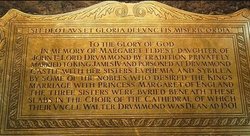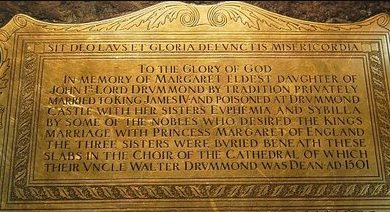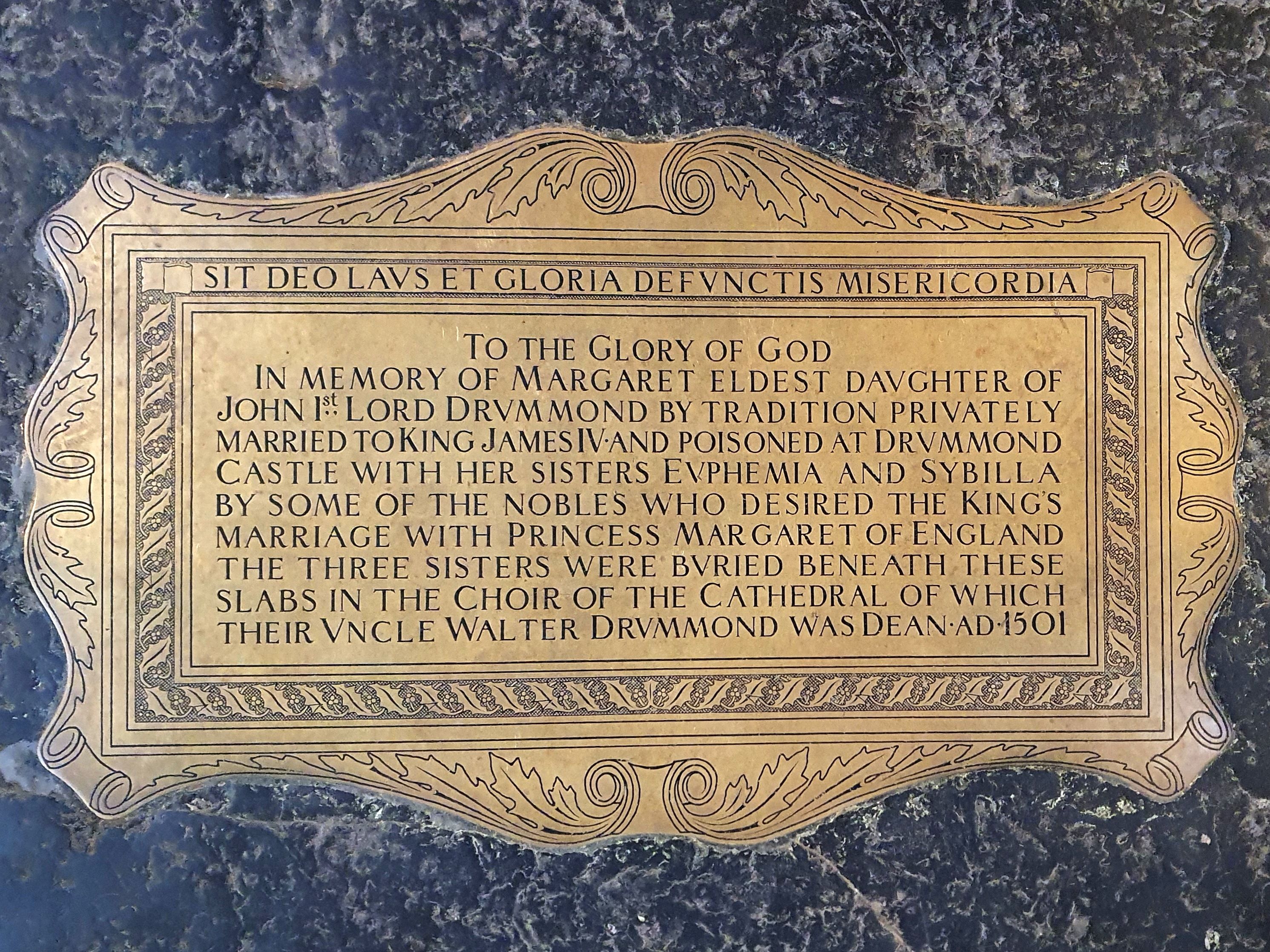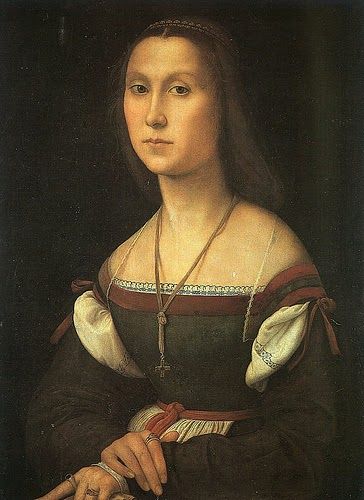James IV of Scotland, born in 1473, ascended the throne in 1488 at the age of 15 when his father died at the Battle of Sauchieburn. At least nominally the head of the rebel force, James, a Catholic, afterwards wore an iron belt apparently for penance and possibly due to the death of his father. A successful monarch, he brought the printing press to Scotland and founded the University of Aberdeen. In 1503, following the death of his beloved mistress Margaret Drummond, James married Margaret Tudor, the daughter of Henry VII and the sister of Henry VIII of England. James fell at the Battle of Flodden
in 1513.
Lady Margaret Drummond was the daughter of Lord John Drummond and Lady Elizabeth Lindsay. The Dictionary of National Biography describes James as 'passionately attached' to Margaret. The couple's daughter, Lady Margaret Stewart, was born about 1497. Margaret Drummond and her sisters Euphemia and Sybilla died of poisoning at Drummond Castle in Perthshire Scotland about 1501. Their bodies were buried in the choir of Dunblane Cathedral.
According to the Dictionary of National Biography 'The child of Margaret Drummond was brought up at the king's expense, and in the "Treasury Accounts" appear payments made at regular intervals for several years to priests to sing masses for her mother's soul.'
Following are two accounts of Margaret Drummond's life:
Margaret Drummond, his (John Lord Drummond's) eldest daughter, was a lady of rare perfections and singular beautie. With her, the young King James the Fourth was so deeply inamoured, that without acquainteing his nobles or councell he was affianced to her, in order to have made her his Queen; but so soon as his intention was discovered, all possible obstructions were made both by the nobilitie, who designed ane alliance with a daughter of England, as a mean to procure peace betwixt the nations, and by the clergie, who declared against the lawfulnes of the marriage, because they were within the degrees of consanguinitie forbidden by the cannon law : nevertheless, the King, under promise, got her with child, which proved a daughter, and was called Lady Margaret Stuart. But he was so much touched in conscience for the ingadgement he had made to the young lady, that notwithstanding the weakness of the royal familie, he rejected all propositions of marriage so long as she lived : for he was crowned in the year 1488 at the age of fexteen, and did not marrie until the year 1502, when he was near thirty, and about a year after her death, which was effected not without suspicion of poyson ; for the common tradition goes, that a potion was provyded in a breakfast to dispatch her for liberateing the King from his promise, that he might match with England ; bot so it happened, that she called two of her sisters, then with her in Drummond, to accompany her that morning, to wit, Lilias Lady Fleming, and a younger, Sybilla, a maid, whereby it fell out that all the three were destroyed with the force of the poyson. They ly buried in a curious vault, covered with three faire blew marble stones joyned closs together, about the middle of the queer of the cathedral church of Dumblane; for about this time the burial place for the familie of Drummond at Innerpeffrie was not yet built. The monument which containes the ashes of these three ladyes, stands intire to this day, and confirmes the credit of this sad storie.
The King greeved for the death of his mistress, takes care for the daughter, lady Margaret Stuart, which Mrs. Margaret Drummond did bear him in the year 1497, and disposed of her in marriage to John Lord Gordon, eldest sone to the Earle of Huntly, a gallant hansome youth new come from his travells and breeding abroad.
— Genealogy of the House of Drummond, William Drummond, 1st Viscount of Strathallon, 1681, p 138.
Margaret, whose tragic fate is a matter of history. A strong attachment took place between her and the Duke of Rothesay, afterwards King James IV. The nobles were not in favour of a third Drummond Queen in the royal family. About 1496 she was living at Stirling under the charge of Sir John and Lady Lundy of that Ilk, then keepers of the Castle. In October of that year she was removed to Linlithgow, and her expenses are mentioned in the Treasurer's Accounts, sometimes under the initials M. D. About 1497 she bore a daughter to the King, who was afterwards married to John, Lord Gordon, and then to her kinsman, Sir John Drummond of Innerpeffray. Shortly after April 1502 Margaret Drummond, together with her sisters Euphemia and Sibylla, while residing at Drummond Castle, were seized with illness after partaking of food, and died after much suffering, not without strong popular suspicion of poisoning.
—The Scots peerage : founded on Wood's Ed. of Sir Robert Douglas's Peerage of Scotland and published 1904-1914, Vol 7 p 44.
lili li née Loretta McKay Masters
James IV of Scotland, born in 1473, ascended the throne in 1488 at the age of 15 when his father died at the Battle of Sauchieburn. At least nominally the head of the rebel force, James, a Catholic, afterwards wore an iron belt apparently for penance and possibly due to the death of his father. A successful monarch, he brought the printing press to Scotland and founded the University of Aberdeen. In 1503, following the death of his beloved mistress Margaret Drummond, James married Margaret Tudor, the daughter of Henry VII and the sister of Henry VIII of England. James fell at the Battle of Flodden
in 1513.
Lady Margaret Drummond was the daughter of Lord John Drummond and Lady Elizabeth Lindsay. The Dictionary of National Biography describes James as 'passionately attached' to Margaret. The couple's daughter, Lady Margaret Stewart, was born about 1497. Margaret Drummond and her sisters Euphemia and Sybilla died of poisoning at Drummond Castle in Perthshire Scotland about 1501. Their bodies were buried in the choir of Dunblane Cathedral.
According to the Dictionary of National Biography 'The child of Margaret Drummond was brought up at the king's expense, and in the "Treasury Accounts" appear payments made at regular intervals for several years to priests to sing masses for her mother's soul.'
Following are two accounts of Margaret Drummond's life:
Margaret Drummond, his (John Lord Drummond's) eldest daughter, was a lady of rare perfections and singular beautie. With her, the young King James the Fourth was so deeply inamoured, that without acquainteing his nobles or councell he was affianced to her, in order to have made her his Queen; but so soon as his intention was discovered, all possible obstructions were made both by the nobilitie, who designed ane alliance with a daughter of England, as a mean to procure peace betwixt the nations, and by the clergie, who declared against the lawfulnes of the marriage, because they were within the degrees of consanguinitie forbidden by the cannon law : nevertheless, the King, under promise, got her with child, which proved a daughter, and was called Lady Margaret Stuart. But he was so much touched in conscience for the ingadgement he had made to the young lady, that notwithstanding the weakness of the royal familie, he rejected all propositions of marriage so long as she lived : for he was crowned in the year 1488 at the age of fexteen, and did not marrie until the year 1502, when he was near thirty, and about a year after her death, which was effected not without suspicion of poyson ; for the common tradition goes, that a potion was provyded in a breakfast to dispatch her for liberateing the King from his promise, that he might match with England ; bot so it happened, that she called two of her sisters, then with her in Drummond, to accompany her that morning, to wit, Lilias Lady Fleming, and a younger, Sybilla, a maid, whereby it fell out that all the three were destroyed with the force of the poyson. They ly buried in a curious vault, covered with three faire blew marble stones joyned closs together, about the middle of the queer of the cathedral church of Dumblane; for about this time the burial place for the familie of Drummond at Innerpeffrie was not yet built. The monument which containes the ashes of these three ladyes, stands intire to this day, and confirmes the credit of this sad storie.
The King greeved for the death of his mistress, takes care for the daughter, lady Margaret Stuart, which Mrs. Margaret Drummond did bear him in the year 1497, and disposed of her in marriage to John Lord Gordon, eldest sone to the Earle of Huntly, a gallant hansome youth new come from his travells and breeding abroad.
— Genealogy of the House of Drummond, William Drummond, 1st Viscount of Strathallon, 1681, p 138.
Margaret, whose tragic fate is a matter of history. A strong attachment took place between her and the Duke of Rothesay, afterwards King James IV. The nobles were not in favour of a third Drummond Queen in the royal family. About 1496 she was living at Stirling under the charge of Sir John and Lady Lundy of that Ilk, then keepers of the Castle. In October of that year she was removed to Linlithgow, and her expenses are mentioned in the Treasurer's Accounts, sometimes under the initials M. D. About 1497 she bore a daughter to the King, who was afterwards married to John, Lord Gordon, and then to her kinsman, Sir John Drummond of Innerpeffray. Shortly after April 1502 Margaret Drummond, together with her sisters Euphemia and Sibylla, while residing at Drummond Castle, were seized with illness after partaking of food, and died after much suffering, not without strong popular suspicion of poisoning.
—The Scots peerage : founded on Wood's Ed. of Sir Robert Douglas's Peerage of Scotland and published 1904-1914, Vol 7 p 44.
lili li née Loretta McKay Masters







